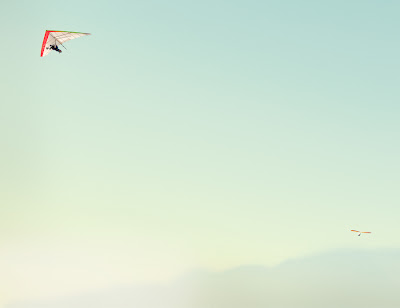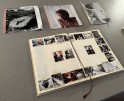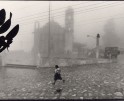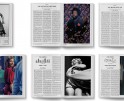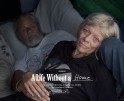Success Stories: Kerry Mansfield
Kerry Mansfield is a success story on so many levels. Her commitment to her craft, her honesty and bravery in sharing personal challenges, and her continuing evolution as an artist all contribute to her her success as a photographer, plus she recently opened a solo exhibition of her new work, Grounded, at the Jennifer Schwartz Gallery in Atlanta that will run through May 12th, 2012. It’s wonderful to celebrate this joy-infused body of work that leaves the viewer soaring.
Born and raised in New Jersey, Kerry moved to Los Angeles when she was 16. She attended UC Berkeley, majoring in social theory and photography, and then studied Architecture at California College of the Arts. She returned to her photographic roots and for the last ten years has been working in the commercial photography business in San Francisco. Diagnosed with breast cancer in 2005, her life took a new turn, but by sharing her visual diary she helped us to understand the journey and insights of being a cancer survivor. Her new series, Grounded, celebrates life with gusto.
GROUNDED: In the late summer of 2009, a long and severe depression took over my existence with no respite in sight. Neither medications nor well meaning friends and family could pull me up out of a growing world of darkness. Lost in my interior world and purposefully isolated from loved ones there was only one place that I could go and find relief from the familiar abyss. There, sheer cliffs perched on the edge of the Pacific Ocean provided a natural refuge where I could lose myself completely awed by the immense views and my feeling of insignifance next to them. For the first time in my artistic career I brought my camera with me in an effort to understand my feelings of hopelessness and carry home a sense of serenity I always felt there.
“Grounded” is the culmination of that time and the impulses that brought me there. Settled now and truly stable in my daily existence, I finally felt safe approaching those images and sharing my experience through them. I began to revisit the way in which we inhabit the space at the boundaries of land, sea and sky. I kept returning to certain images that somehow felt like a balance between the unease and the peace I felt during the hours I spent at the edge of the ocean. Over time, the consistent thread in my work of capturing spaces, their boundaries and the concept of home began to weave its way into these images. The figures in these compositions represent less the individuals in the pictures but an unexplained attraction to the edges of our environment. We all seem drawn to a seashore, the crest of a tall hill, or even the sky, dangerously out of reach. When I find myself in these places, a sense of my own small place within the environment could easily elicit a sense of fear and unease, yet, inexplicably I find a peace not often found in the places over which I control.
Congratulations Kerry, on your new body of work and you exhibition at the Jennifer Schwartz Gallery! This work really represents so much more that just the image–it feels like you are ready to fly and soar and more forward. Tell us how the work came about?
When I started shooting I really had no intention of sharing the images or creating a series from them at all. I went through a very rough time in 2009 and struggled with a severe depression that almost propelled me to take my own life. It’s a bit ironic considering how hard I fought to stay alive when I had cancer years before but I had a very hard time reorienting my life after my illness and a string of very unsatisfying jobs and relationship issues made it hard to move forward. The place in these images has always been a refuge for me from my daily life in the city. In a painful turn of events (which are too private to share) I finally came out the other side and then decided to take photos just for my own mental health in 2010 because I felt this location played a huge part in saving my life. I owed it to the landscape in an odd way.
Grounded feels like a completely new way of working and seeing for you–it’s joyful, stripped down, and specific. Is this a new direction?
Absolutely. My Borderline series took almost 10 years to complete because I worked full time and did my artwork on evenings and weekends. The work is extremely complex and very visually “busy”. Then I released Aftermath which was a radical departure from my fine art work. At that time I was becoming a bit obsessed with the question “How little do you need to have in a picture to consider it a photograph?” One of my inspirations was Orit Raff who had the most stunning photo of a white dishcloth and nothing else. The simplicity and beauty seemed so perfectly done and the image almost felt “empty”. With Grounded I tried to create “canvases” of spatial compositions that were similar and painfully simple. The figures are the actual subjects of the images but they are almost imperceptible as well. Essentially, for me Grounded has fields of color that provide both calm and a sense of unease with their simplicity.
Is the series finished?
I haven’t decided to be honest. The lighting is best during September so I may head back out and try to make new images with the same thesis. I’ll keep you posted on that one . . .
A lot of your earlier work feels like it deals with introspection–what were your thoughts when making The Cabin and Borderline?
Honestly, I love the Cabin series. Again, due to it’s simplicity and the cabin is also where I shot my first Borderline image so they are intertwined in my mind. The images from the Cabin work were a study in everyday objects that took on a rich history of the people who occupied it over time. Essentially, the photos are formal portraits of objects. Even the walls themselves radiated the memories of time spent there by dozens of women over a 20 year span. The Cabin no longer exists so now the work has an aspect of anthropology and archeology as well.
Borderline started as a bizarre experiment when I saw a reflection outside the cabin window and also saw the inside at the same time. I had no idea what the film would actually record so when I got my contact sheets I was hooked on the odd separation of space. Since I have studied both architecture and interior design the work became a natural extension of my attraction to spatial compositions. Then I got, yet again, obsessed with hunting down the circumstances that create a Borderline image to find as many as possible. It took a long time and I edited out so many images along the way but at the end the final collection is a true overview of that 10 year period. The original image from the cabin is still in the series.
Aftermath is such a powerful series. It was an incredibly brave project. Can you speak about it, and also the result of sharing such a personal story?
Well, often people tell me that it was a brave thing to shoot and share but quite frankly, there’s a fine line between bravery and stupidity and I feel like it was the latter. When I released Aftermath on the PDN “Photo of the Day” blog I honestly thought that only fellow photographers would see the work. I had no idea how far it would travel and how many people outside of our community would see it. That same day the team of people that I managed at work saw the series on Reddit and several other sites so everyone had seen me half naked. I went home a bit stunned and dazed but once it was out there was no going back. Today I feel so blessed with the awards the series has garnered. That said, I still haven’t had a solo show for the entire series. I’m holding out hope that there is a museum or gallery owner who has the courage to put it on the walls and stand by the decision. It’s hard work to look at but if art doesn’t make you a little uncomfortable every once and a while I don’t think it’s done it’s job.
Does having survived cancer change your outlook as a photographer?
It’s changed my outlook as a human being first. I have no fear of death. None. If I’m here for another year or another 30 I’m just trying to use the time to complete as many projects as I can conjure up. Sometimes I get a bit restless with my work and wish I was further along in my career because I had to spend over a year sick in bed and everyone else continued to move forward and prosper. I’m an obsessive compulsive person by nature so I suffer from never feeling satisfied with my work. On the one hand it makes me work harder than almost all of my friends but also can leave me constantly dissatisfied. For example, Grounded was accepted into Review Santa Fe last week but I got sad when I didn’t win one of the awards! Life is short and I’ve got a lot left to do so I just put more energy into my work and push forward.
What advice can you give emerging photographers, especially on presentation, on networking, on consistently producing excellent work?
Just don’t stop creating work because that’s the death of an artist. It doesn’t even have to be good but if you continue to shoot and hone your eye over time eventually you’ll make something that stuns people. My motto is the tried and true “Never, Never, Never, Never, Never give up.” by Winston Churchill.
What opportunity took your career to the next level?
Review Santa Fe in 2009. I took Borderline out from under my bed and jumped on a plane to New Mexico. The rest has tumbled out of those connections and my endless attempts to get my work out in front of the public. When you’re unknown you’re the only person who’s going to “sell” your work and yourself. I don’t take this lightly and probably spend 50% of my artistic time simply promoting.
How do you keep yourself creatively motivated?
It’s actually a compulsion. When I’m not making pictures I feel hollow inside. I took a year off in 2007 and the depression started creeping in. I learned the hard way that my work keeps me sane, on a good day.
And finally, what would be your perfect day?
Two hours of yoga. A long walk either on the coast or in the mountains with my fiancé and dog.Then, after a dinner at my favorite vegetarian restaurant, consuming at least two different dark chocolate desserts. Because hey, life is short.
Posts on Lenscratch may not be reproduced without the permission of the Lenscratch staff and the photographer.
Recommended
-
Suzanne Theodora White in Conversation with Frazier KingSeptember 10th, 2025
-
Maarten Schilt, co-founder of Schilt Publishing & Gallery (Amsterdam) in conversation with visual artist DM WitmanSeptember 2nd, 2025
-
BEYOND THE PHOTOGRAPH: Q&A WITH PHOTO EDITOR JESSIE WENDER, THE NEW YORK TIMESAugust 22nd, 2025
-
Beyond the Photograph: Editorial Q&A with Photographer Tamara ReynoldsJuly 30th, 2025

